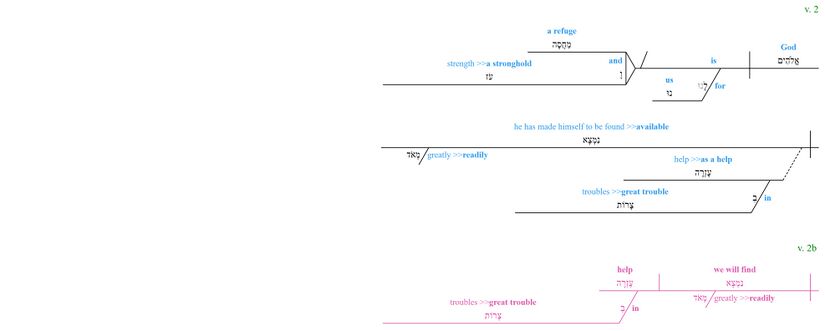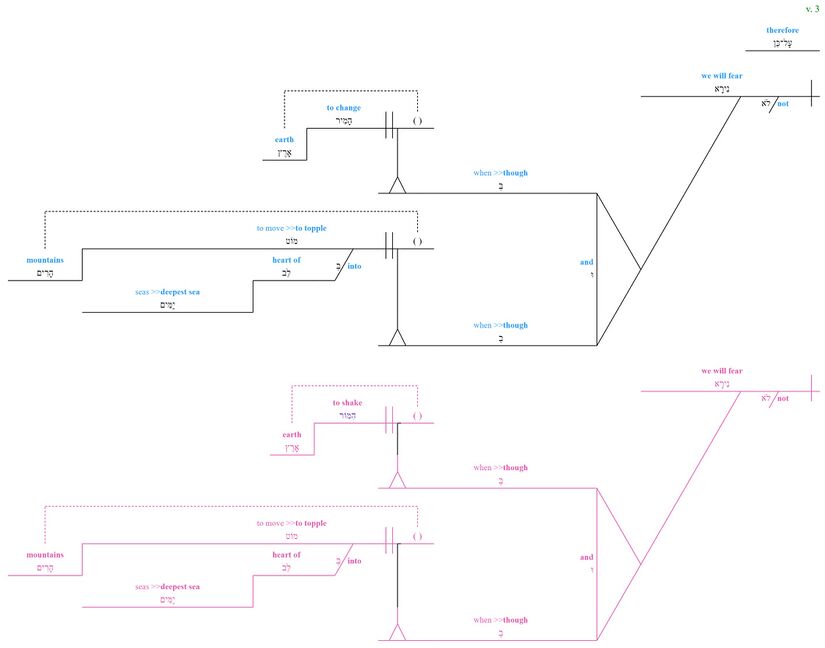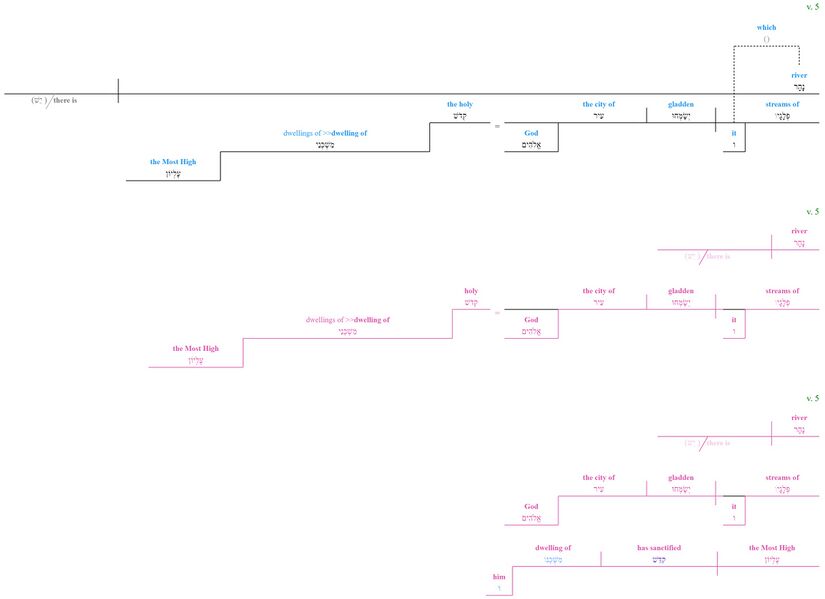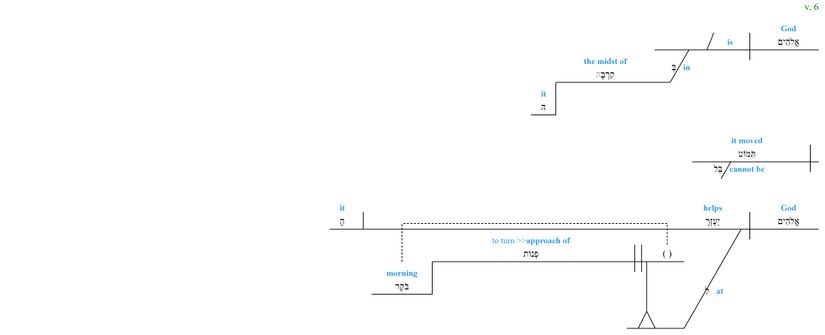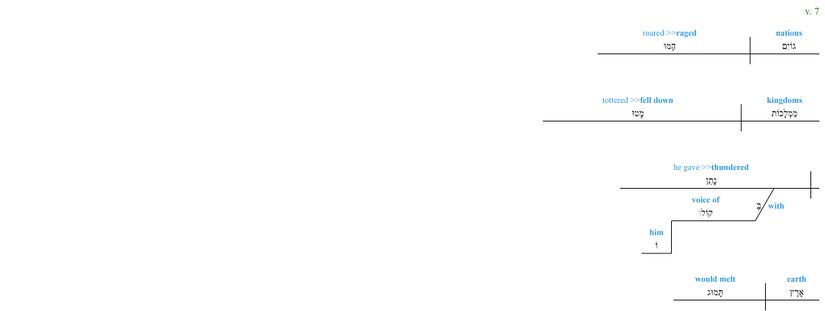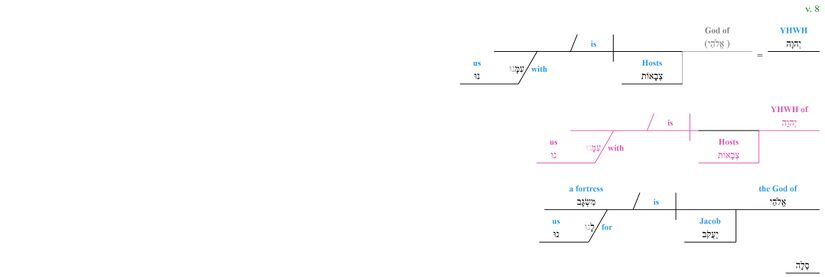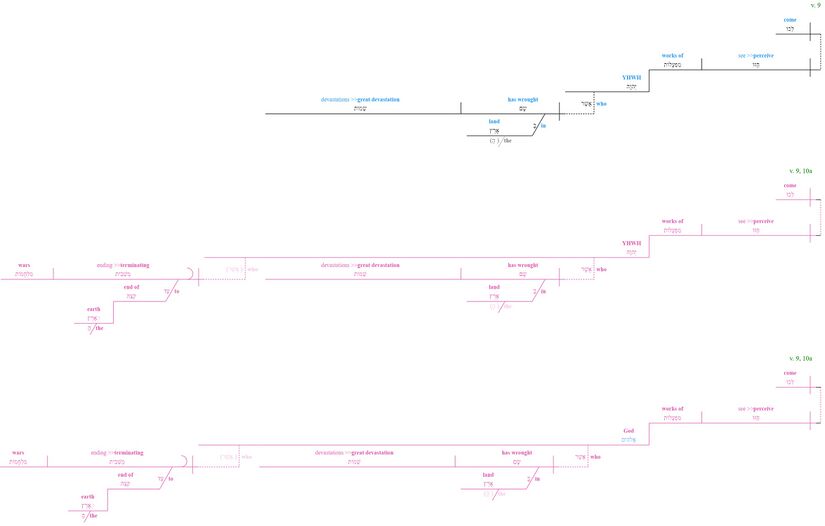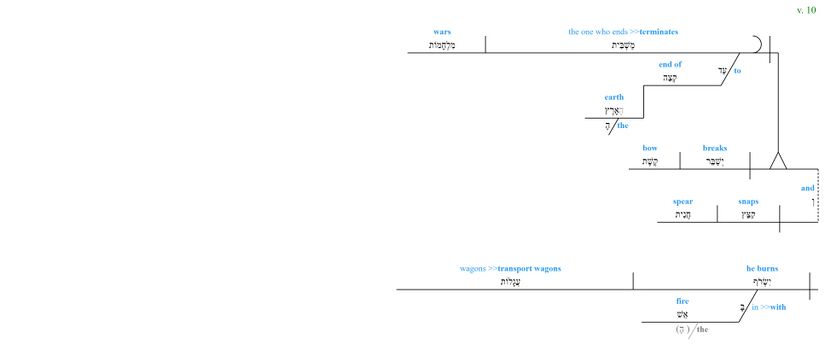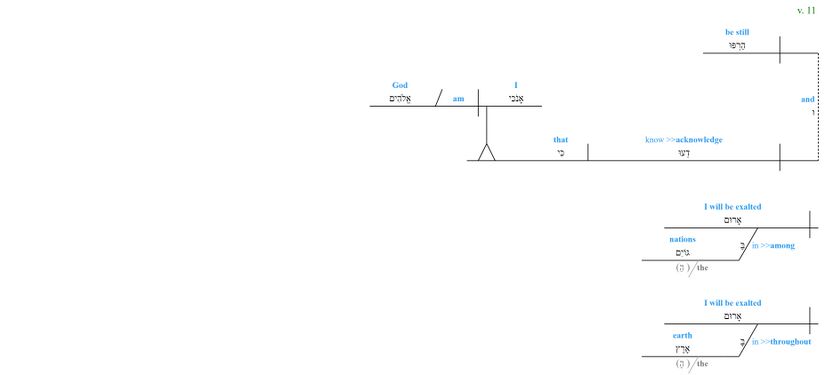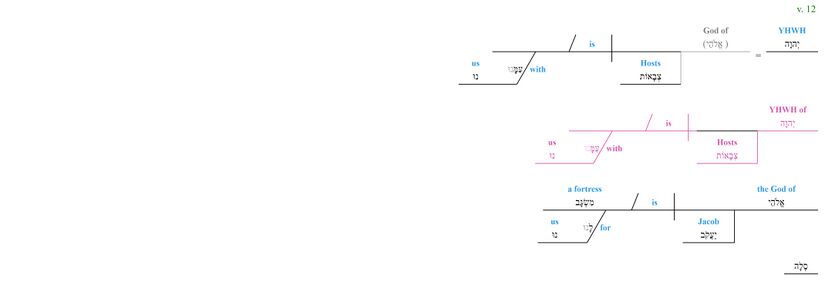Psalm 46 Grammar
About the Grammar Layer
The grammar layer visually represents the grammar and syntax of each clause. It also displays alternative interpretations of the grammar. (For more information, click "Expand" to the right.)
The grammatical diagram provides a way to visualise how different parts of a sentence work together. It represents the “surface-level” grammar, or morphosyntax, of a sentence. Morphosyntax includes both the form of words (morphology) and their placement in the sentence (syntax). This approach to visualising the text, based on the Reed-Kellogg diagramming method, places the grammatical subject in one slot, the verb in another slot, and modifiers and connectives in other slots.
For a detailed description of our method, see the Grammar Creator Guidelines.
Grammar Visuals for Psalm 46
| Visualization | Description |
|---|---|
| The clause is represented by a horizontal line with a vertical line crossing through it, separating the subject and the verb. | |
| The object is indicated by a vertical line that does not cross the horizontal line of the clause. Infinitives and participles may also have objects. If the direct object marker (d.o.m.) is present in the text, it appears in the diagram immediately before the object. If the grammar includes a secondary object, the secondary object will appear after the object, separated by another vertical line that does not cross the horizontal line of the clause. | |
| The subject complement follows the verb (often omitted in Hebrew) separated with a line leaning toward the right. It can be a noun, a whole prepositional phrase or an adjective. The later two appear modifying the complement slot. | |
| When a noun further describes or renames the object, it is an object complement. The object complement follows the object separated by a line leaning toward the right. | |
| In a construct chain, the noun in the absolute form modifies the noun in the construct form. | |
| Participles are indicated in whatever position in the clause they are in with a curved line before the participle. Participles can occur as nominal, where they take the place of a noun, predicate, where they take the place of a verb, or attributive, where they modify a noun or a verb similar to adjectives or adverbs. | |
| Infinitives are indicated by two parallel lines before the infinitive that cross the horizontal line. Infinitive constructs can appear as the verb in an embedded clause. Infinitive absolutes typically appear as an adverbial. | |
| The subject of the infinitive often appears in construct to it. In this situation, the infinitive and subject are diagrammed as a construct chain. | |
| The object of the infinitive is indicated by a vertical line that does not cross the horizontal line of the infinitival clause. | |
| Modifiers are represented by a solid diagonal line from the word they modify. They can attach to verbs, adjectives, or nouns. If modifying a verb or adjective, it is an adverb, but if modifying a noun, it is an adjective, a quantifier, or a definite article. If an adverb is modifying a modifier, it is connected to the modifier by a small dashed horizontal line. | |
| Adverbials are indicated by a dashed diagonal line extending to a horizontal line. These are nouns or infinitives that function adverbially (modifying either a verb or a participle), but are not connected by a preposition. | |
| Prepositional phrases are indicated by a solid diagonal line extending to a horizontal line. The preposition is to the left of the diagonal line and the dependent of the preposition is on the horizontal line. They can modify verbs (adverbial) or nouns (adjectival). | |
| Embedded clauses are indicated by a "stand" that looks like an upside-down Y. The stand rests in the grammatical position that the clause fulfills. Extending from the top of the stand is a horizontal line for the clause. If introduced by a complementizer, for example כִּי, the complementizer appears before the stand. Embedded clauses can stand in the place of any noun. | |
| When clauses are joined by a conjunction, they are compound clauses. These clauses are connected by a vertical dotted line. The conjunction is placed next to the dotted line. | |
| Within a clause, if two or more parts of speech are compound, these are represented by angled lines reaching to the two compound elements connected by a solid vertical line. If a conjunction is used, the conjunction appears to the left of the vertical line. Almost all parts of speech can be compound. | |
| Subordinate clauses are indicated by a dashed line coming from the line dividing the subject from the predicate in the independent clause and leading to the horizontal line of the subordinate clause. The subordinating conjunction appears next to the dashed line. | |
| Relative clauses also have a dashed line, but the line connects the antecedent to the horizontal line of the relative clause. The relative particle appears next to the dashed line. | |
| Sentence fragments are represented by a horizontal line with no vertical lines. They are most frequently used in superscriptions to psalms. They are visually similar to discourse particles and vocatives, but most often consist of a noun phrase (that does not refer to a person or people group) or a prepositional phrase. | |
| In the body of the psalm, a horizontal line by itself (with no modifiers or vertical lines) can indicate either a discourse particle or a vocative (if the word is a noun referring to a person or people group). A discourse particle is a conjunction or particle that functions at the discourse level, not at the grammatical level. Vocatives can appear either before or after the clause addressed to them, depending on the word order of the Hebrew. | |
| Apposition is indicated by an equal sign equating the two noun phrases. This can occur with a noun in any function in a sentence. |
| Hebrew text colors | |
|---|---|
| Default preferred text | The default preferred reading is represented by a black line. The text of the MT is represented in bold black text. |
| Dispreferred reading | The dispreferred reading is an alternative interpretation of the grammar, represented by a pink line. The text of the MT is represented in bold pink text, while emendations and revocalizations retain their corresponding colors (see below). |
| Emended text | Emended text, text in which the consonants differ from the consonants of the Masoretic text, is represented by bold blue text, whether that reading is preferred or dispreferred. |
| Revocalized text | Revocalized text, text in which only the vowels differ from the vowels of the Masoretic text, is represented by bold purple text, whether that reading is preferred or dispreferred. |
| (Supplied elided element) | Any element that is elided in the Hebrew text is represented by bold gray text in parentheses. |
| ( ) | The position of a non-supplied elided element is represented by empty black parentheses. For example, this would be used in the place of the noun when an adjective functions substantivally or in the place of the antecedent when a relative clause has an implied antecedent. |
| Gloss text colors | |
|---|---|
| Gloss used in the CBC | The gloss used in the Close-but-Clear translation is represented by bold blue text. |
| Literal gloss >> derived meaning | A gloss that shows the more literal meaning as well as the derived figurative meaning is represented in blue text with arrows pointing towards the more figurative meaning. The gloss used in the CBC will be bolded. |
| Supplied elided element | The gloss for a supplied elided element is represented in bold gray text. |
v. 1
v. 2
- In v. 2b, the form נִמְצָא can be read in three ways: a.) as a qatal of the tolerative niphal (preferred); b.) as a 1cpl qal yiqtol (disprefrerred); and c.) as a ms niphal participle (dispreferred).
- Here, taking נִמְצָא as a qatal (has made himself to be found) is favored (although in CBC, it is smoothed out as is readily available; modern translations tend to be very paraphrastic as well, making it difficult to tell what they are paraphrasing, a qatal or a ms participle [cf. "an ever-present help in trouble", NIV; cf. NLT; ESV; NASV; NKJV; JPS1917; NRSV; HOF; NBS; etc]). The LXX has βοηθὸς ἐν θλίψεσιν ταῖς εὑρούσαις ἡμᾶς σφόδρα, wherein ταῖς εὑρούσαις modifies afflictions, not God (NETS: "God is our refuge and power, very much a helper in afflictions that befall us"; cf. Vulg.; Luther 2017; WYC; UKR). The niphal of מצא with God as subject is well-attested in the Hebrew Bible (e.g., Isa 65:1: נמצאתי ללא בקשני/“I permitted myself to be found by those who did not seek me” [NASB]; cf. ראה in niphal in Ex 33:23 [sich sehen lassen[1]) and is preferred by a number of scholars (cf. "a very present help in trouble] Lit., a help in distresses hath he let himself be found exceedingly"[2]; "The niph'al in v. 1b should be taken in a reflexive [tolerative] rather than a passive sense (Duhm, Eaton), and the perfect needs to be translated in contrast with the imperfects in v. 3: 'He has made himself to be found indeed,' 'he has plainly shown himself'..." [3]). Based on such usage of מצא with God, v. 2b could indicate that the community in distress (בצרות) has sought God and he responded favorably by making himself available to them (cf. Jer 29:14; equally however, God can let people find him even when they do not seek him [cf. Isa 65:1]).
- Reading נִמְצָא as a 1cpl qal yiqtol (i.e., “we find him when [we are] in trouble”) is also viable on syntactic and semantic grounds, yet it has no strong versional support and is not well-represented in modern translations. For this reading, see cf. Targ., whose נשכח seems to take the MT's נמצא as a 1cpl yiqtol (see further Stec [2004: 98, n2], which translates v. 2 as "God is our security and strength; we will readily find help in trouble"; cf. Coverdale Bible of 1535: "In oure troubles and aduersite, we haue founde, that God is oure refuge, oure strength and helpe"). If accepted, this reading would also impact the text structurally and poetically, disrupting the "symmetry" between vv. 2a and 2b (and vv. 8 and 12, in which God is subject and the focus is on his roles and status). Notably, scholars point out that v. 2 could be viewed as an additional refrain in the psalm (cf. vv. 8 and 12).
- Alternatively, נִמְצָא can be taken as a ms passive participle (cf. EHV; HCSB ). Cf. "a Hebrew phrase (nimṣā’ mĕ’ōd) that may be woodenly translated ‘is found greatly’. Therefore, it is an intensifying phrase, well rendered by ‘ever-present’, although it could conceivably be ‘well proved’ (see NRSV alternative)."[4] But the temporal בצרות ("in great trouble") would suggest an interrupted action, calling for a yiqtol, not a participle which normally represents an uninterrupted event.
v. 3
- In v. 3b, MT has בְּהָמִיר, which is usually taken as the hiphil infinitive construct of מור I/“to change” (thus, “though the earth change..." or is "altered”; cf. NRSV, NASB1995, KJ21, etc.; cf. α': ἐν τῶι ἀνταλλάσσεσθ(αι) γῆν from "to change/exchange"). The LXX, however, has ἐν τῷ ταράσσεσθαι (from "to be agitated, troubled", "to be disquieted/restless"; cf. Pesh. ܕܙܝܥܐ , "to shake"[5]). Accordingly, some (e.g., HALOT, 560 s.v. II מור; BHS) suggest emending בְּהָמִיר to a niphal of מוּר II, i.e., "to shake" (cf. NASB, NET, NLT [“So we will not fear when earthquakes come... ”], HFA, NGÜ, ELB, EÜ, GNB; CSB, CEB [“That’s why we won’t be afraid when the world falls apart...”]) or to הִמּוֺג, a niphal of מוג/“to melt/dissolve” (SDBH) (e.g., Kraus goes with הִמּוֺג rendering it as "shaking"[6]; cf. the use of מוג in v. 7b, in parallel to מוט; cf. Ps 75:3 which has נמגים, a niphal of מוג with the "earth" and its inhabitants as subject). With "shaking" here, as well as later in v. 7 (ἐσαλεύθη ἡ γῆ, "the earth was shaken" [NETS; a generalization via the LXX's preferred word in the Psalter[7]]; cf. Pesh.: ܘܙܥܬ ܐܪܥܐ "and the earth shakes"[8]), the LXX and Pesh. seem to understand the image of an earthquake throughout the psalm, not only in vv. 2-4. Additionally, in v. 4, the LXX uses the same word with waters (ἐταράχθησαν τὰ ὕδατα αὐτῶν) and mountains (ἐταράχθησαν τὰ ὄρη) (NETS [45:3-4]: "Therefore we will not fear, when the earth is troubled and mountains be transposed in hearts of seas. Their waters roared and were troubled; the mountains were troubled by his force"). As it stands, the MT's בְּהָמִיר is viable semantically and is reflected in many modern translations.
- Furthermore, in v. 3c, the MT has בְּלֵב יַמִּים ("in the heart of... ", singular), but the LXX has ἐν καρδίαις θαλασσῶν (“in hearts of seas”). This could be a case of harmonization with the plural form of "seas." The plural יַמִּים is taken here as amplified, i.e., representing an extremely deep sea.[9] Note also that v. 4 uses 3ms suffixes in relation to the seas (“its”; i.e., “its waters,” “its swelling”).
v. 4
- In CBC, v. 4 is rendered as "Though its waters foam in rage. Though mountains quake at its surging." In v. 4a, the two verbs יהמו יחמרו are taken as a serial verb construction, i.e., “a sequence of verbs which act together as a single predicate. Serial verbs are always monoclausal and are pronounced as a single verb would be. The components of a serial verb construction share tense, aspect, modality, reality status, evidentiality, mood, and also polarity values. A serial verb construction typically refers to what can be conceptualized as one event, and one recognizable event type, in terms of cultural stereotypes available to the speakers. Serial verbs tend to share at least one argument. An overwhelming majority of serial verbs have a single overall argument structure, with the subjects, objects and obliques belonging to the whole construction.”[10] These verbal forms (and clauses) are then taken as a semantic continuation of the events of the infinitival clauses in v. 3.[11]
v. 5
- In v. 5, נהר is taken as a verbless clause with an elided יש, followed by an asyndetic relative clause (v. 5b), with a fronted subject (פלגיו ; cf. Deut 8:9; 29:17; Ps 26:10; 144:7-8, 11; Prov 2:14-15; Eccl 10:16-17). In terms of information packaging, v. 5a is a presentational clause, indicating the beginning of a new section (vv. 5–7). Alternatively, v. 5b can be taken as an independent clause, after a sentence fragment (e.g., "A river! Its streams cause rejoicing for the city of God..."[12], although this reading is not well-represented among modern translations. For the MT's 5a (נהר פלגיו), however, some versions use a different syntax, with the LXX and Pesh. both having genitive constructions (τοῦ ποταμοῦ τὰ ὁρμήματα and ܬ̈ܦܐ ܕܢܗܪ̈ܘܬܐ respectively) as subjects of the verb "to gladden". Hence, the LXX: "The river’s strong currents make glad the city of God ...' (NETS); Pesh.: "Streams of rivers will cause gladness in the city of our God ...".[13] Some scholars have proposed to realign vv. 4-5. E.g., Briggs and Briggs connect נהר with v. 4 and the word “swelling” in it. Repositioned this way, נהר/"stream" becomes part of the sea in vv. 3-4 (cf. Pss 93:3) and פלגיו/'his brooks" are taken as God's (metaphoric) brooks of blessings.[14] Such realignment is not reflected in ancient or modern translations.
- In v. 5c, the LXX diverges from the MT (קְדֹשׁ מִשְׁכְּנֵי עֶלְיוֹן; "the holy dwelling of the Most High"), containing ἡγίασεν τὸ σκήνωμα αὐτοῦ ὁ ὕψιστος ("the Most High sanctified his covert" [NETS]; cf. Vulg). It appears to presuppose a piel verb קִדֵּשׁ (“ to make holy/sanctify”) and understand the next form as “his [God's] dwelling place” (singular). Presumably, the LXX reads the final yod of משכני as a waw. Barthélemy sees both MT's קְדֹשׁ and מִשְׁכְּנֵי עֶלְיוֹן as "highly probable with a certain margin of doubt"[15] and most modern translations follow the MT over and against the LXX.[16] Intriguingly, Dahood realigned vv. 4-5, reading v. 5bc as "God brings happiness to his city, the Most High sanctifies his habitation."[17] In his understanding, "the river and its channels" should be linked to the word סלה (v. 4), which he read in light of Exod 15:8. Thus, he took the whole collocation to mean "the river and its channel stand in a heap." This reading has no support among the versions and is not represented in any major translations. As to the LXX (cf. BHS), it likely reflects the unusual nature of the construction in the MT (note that the plural form of משכן is usually משכנות [cf. Pss. 43:3; 84:1; 132:5]). Notably, the LXX also adds the definite article to "city", which leads some to think that this collocation ("the city of God") refers to Jerusalem.[18] Here, the MT is taken as a preferred reading, understanding קְדֹשׁ as an adjective used substantivally (IBHS 14.3.3.b; for Ps 46:5, see n19; cf. Exod 15:16; Ps 65:5).
v. 6
v. 7
- In v. 7b, the MT has נתן בקולו, which literally means "he gave with his voice". Per GK119q, the noun "voice" with the preposition ב is taken as an adverbial complement, "he thundered with his voice" (i.e. "mightily"; cf. IBHS 11.2.5d; cf. GNV; GNT; cf. ISV: "his voice boomed", etc.; plus, ANE theophanies featuring storm deities). In 2 MSS, קולו appears without the preposition ב; but נתן + ב + קול is well-attested in the Hebrew Bible (cf. Ps 68:33/34; Jer 12:8) and can be viewed as a variant of נתן + קול.[19]
- Generally, Psalm 46 does not use many articles, and is inconsistent in its usage with ארץ ("earth"). In v. 7, the MT does not have it with ארץ; but some MSS and the LXX read "the earth".
v. 8
- In the refrain in vv. 8 and 12, the divine name יהוה צבאות is understood as being short for "YHWH, [the God] of Hosts," wherein the two elements are in apposition[20], with the second member, "[the God of] Hosts", specifying the status and role of the first member, "YHWH", i.e., YHWH is a deity who possesses and commands heavenly hosts or armies. In other words, YHWH here is cast as a warrior who leads his heavenly (and human) armies into battle (cf. 1 Sam 17:45, which has יהוה צבאות אלהי מערכות ישראל). Without restoring "the God of", some render this name as "Yhwh Armies".[21]
- For the MT's משגב־לנו ("a fortress for us") in vv. 8, and 12, the LXX has ἀντιλήμπτωρ ἡμῶν, "our helper" or "supporter" (NETS; cf. Pesh. has ܘܡܥܕܪܢܢ/"and our helper"[22]), perhaps harmonizing the refrain, conceptually, with v. 2 (cf. Ps 118:7).
v. 9
- The imperatives "Come! Perceive!" (לכו־וראו) are taken as a case of the serial verb construction (cf. v. 4; cf. the LXX's δεῦτε ἴδετε, "Come, see"; cf. לכו וראו [Ps 66:5]; לכו־נא ונוכחה [Isa 1:18]; and לכו ונלכה [1 Sam 9:9], etc.).
- The participle משבית in v. 10a can be taken as introducing a circumstantial clause, i.e., "terminating wars to the end of the earth".[23] Cf. the LXX's δεῦτε ἴδετε τὰ ἔργα κυρίου ἃ ἔθετο τέρατα ἐπὶ τῆς γῆς ἀνταναιρῶν πολέμους μέχρι τῶν περάτων τῆς γῆς (vv. 9-10a), rendered in NETS as, “Come, see the works of the Lord, what feats he put on the earth, canceling wars to the ends of the earth....” But in this case, the clause in Hebrew would begin with a והוא or, to represent the manner by which God creates devastation, it would need an infinitive const. with ל. Some take משבית as starting an asyndetic relative clause. Cf. Kraus, who renders all of v. 10 as a series of relative clauses subordinate to v. 9: "Who controls wars to the end of the world, who breaks bows and shatters lances, who burns chariots’ in fire".[24]
- In the preferred option, the participle משבית is understood as a substantive, i.e., “[the] one who terminates wars to the end of the earth". Taken this way, it serves as the subject of the two yiqtols in v. 10bc---“The one terminating wars (or who terminates wars) breaks the bow and snaps the spear.” Separating v. 10 from v. 9 makes v. 10 emphatic: v. 9 mentions “works of the Lord” and "great devastation" which are general (military) deeds undertaken by God. In v. 10, however, the focus shifts to more specific acts (terminating wars and destroying weaponry; on such shift from general to specific, see also Ps 66:5ff, which quotes Ps 46:9a). Furthermore, in vv. 8-12, van der Lugt has identified a series of concentric features in vv. 9-11, which frame v. 10, making it "pivotal".[25] "The double imperatives (lkw h.zw and hrpw wd‘w respectively), exactly at the beginning of the outer verselines (vv. 9 and 11), and b’rs (‘on earth’) exactly at the end of these lines deserve special mentioning".[26] Again, within these frames, v. 10 (with its specific acts of destruction of weapons) could be emphatic. V. 10 also stands out in the strophe and in the psalms as a whole because it is a tricolon.[27] Therefore, some suggest deleting v. 10c altogether. Thus, "An additional line has been added by a later editor to emphasise this destruction, but at the expense of the measure and symmetry of Str., Wagons He burneth in the fire."[28] "This l.[ine] is trimeter and excessive to the Str. and is doubtless a gloss of intensification."[29]
- Additionally, it is of note that some MSS (32 Kenn., 46 De-Rossi), the LXX, and Pesh. read "God" in v. 9 instead of יהוה (Targ. follows MT). For this, see Ps 66:5, which echoes v. 9, but the noun מפעלות/"works" is in construct with "God", i.e., לכו וראו מפעלות אלהים. The more general אלהים in v. 9 fits better with Book II, which is a part of the Elohistic Psalter. Hence, יהוה should be preferred as the original reading.[30]
v. 10
- In v. 10, the final item destroyed by God is עֲגָלוֹת ("carts or transport wagons"). The majority of scholars follow the LXX (θυρεοὺς/"shields"; cf. Targ, Vulg;[31]; cf. NJB, NAB, NEB, FRCL, NIV, GECL) and suggest re-vocalizing the form as עֲגִלוֹת. Others understand it, uniquely, as "chariots" [cf. RSV, TOB, NJV, SPCL]). Here, the MT's עגלות, i.e., "carts" or "transport wagons" is preferred, on which see The Meaning of עגלות in Psalm46:10.
v. 11
v. 12
Bibliography
- Aikhenvald, Alexandra Y. 2018. Serial Verbs. Oxford: Oxford University Press.
- Anderson, Arnold Albert. 1981. The Book of Psalms: Based on the Revised Standard Version. Grand Rapids, MI: Eerdmans.
- Barthélemy, Dominique. 2005. Critique Textuelle de l’Ancien Testament. vol. 4: Psaumes. Fribourg, Switzerland: Academic Press.
- Botterweck, G. Johannes, Helmer Ringgren, and Heinz-Josef Fabry, eds. 1974–2006. Theological Dictionary of the Old Testament, 15 vols. Translated by John T. Willis et al. Grand Rapids, MI: Eerdmans.
- Briggs, Charles Augustus and Emilie Grace Briggs. 1907. A Critical and Exegetical Commentary on the Book of Psalms. vol. 2. ICC. Edinburgh: T&T Clark.
- Brown, Francis, Samuel R. Driver, and Charles A. Briggs. 1906. A Hebrew and English Lexicon of the Old Testament. Oxford: Clarendon.
- Craigie, Peter C., and Marvin E. Tate. 1983. 2nd ed. Psalms 1–50. vol. 19. WBC. Grand Rapids, MI: Zondervan.
- Dahood, Mitchell. 1966. Psalms. Vol. 1. Anchor Bible Commentary. New York: Doubleday.
- DeClaissé-Walford, Nancy, Rolf A. Jacobson, and Beth LaNeel Tanner. 2014. The Book of Psalms. NICOT. Grand Rapids, MI: Eerdmans.
- Delitzsch, Franz. 1883. Biblical Commentary on the Psalms. vol. 1. Translated by Eaton David. New York, NY: Funk and Wagnalls.
- Duhm, Bernhard. 1899. Die Psalmen. KHC XIV. Freiburg.
- Duhm, Bernhard. 1922. Die Psalmen. 2nd edn. KHC XIV. Tübingen.
- Fokkelman, J.P. 2000. Major Poems of the Hebrew Bible: At the Interface of Prosody and Structural Analysis (Vol 2: 85 Psalms and Job 4–14). Studia Semitica Neerlandica. Assen, Drenthe: Van Gorcum.
- Futato, Mark D. 2007. Interpreting the Psalms. Grand Rapids, MI: Kregel.
- Goldingay, John. 2007. Psalms 42–89. vol. 2. BCOT. Grand Rapids, MI: Baker Academic.
- Gunkel, Hermann. 1895. Schopfung und Chaos in Urzeit und Endzeit. Göttingen: Vandenhoeck und Ruprecht.
- Gunkel, Hermann. 1968. Die Psalmen. HK II.2. Göttingen.
- Hengstenberg, Ernst Wilhelm. 1863. Commentary on the Psalms. vol. 2. Edinburgh: T&T Clark.
- Hossfeld, Frank-Lothar, and Erich Zenger. 1993. Die Psalmen I. Echter Verlag.
- Jenni, Ernst. 2012. "Nif’al und Hitpa‘el im Biblisch-Hebräischen". Pages 131-304 in Studien zur Sprachwelt des Alten Testaments III. Stuttgart: Kohlhammer.
- Jacobson, Rolf. A. 2020. "Psalm 46: Translation, Structure, and Theology." Word and World 40: 308-320.
- Koehler, Ludwig, Walter Baumgartner, and Johann J. Stamm. 2001. The Hebrew and Aramaic Lexicon of the Old Testament. 2 vols. Translated and edited under the supervision of Mervyn E. J. Richardson. Leiden: Brill.
- Kraus, Hans-Joachim. 1972. Psalmen 1–63. BKT XV/1. Neukirchen-Vluyn: Neukirchener Verlag.
- Lugt, Pieter van der. 2010. Cantos and Strophes in Biblical Hebrew Poetry Vol. 2. OS. Leiden: Brill.
- Lunn, Nicholas P. 2006. Word Order Variation in Biblical Hebrew Poetry: The Role of Pragmatics and Poetics in the Verbal Clause. Paternoster Biblical Monographs. Milton Keynes: Paternoster.
- Peterson, Eugene H. 2003. The Message. Colorado Springs, CO: NavPress.
- Raabe, P.R. 1990. Psalm Structures. A Study of Psalms with Refrains.Journal for the Study of the Old Testament Supplement Series 104. Sheffield: JSOT Press.
- Ross, Allen. 2013. A Commentary on the Psalms: 42-89. Kregel Exegetical Library. Kregel Academic.
- Tsumura, David Toshio. 1980. “The Literary Structure of Psalm 46, 2-8.” Annual of the Japanese Biblical Institute 6: 29-55.
- VanGemeren, Willem A. 1997. New International Dictionary of Old Testament Theology and Exegesis. 5 vols. Grand Rapids, MI: Zondervan.
- Waltke, Bruce K., James M. Houston with Erika Moore, The Psalms as Christian Worship: A Historical Commentary. Grand Rapids, MI: Eerdmans, 2010.
- Weber, B. 2001 and 2003. Werkbuch Psalmen. 2 vols., Stuttgart: Kohlhammer.
- Weiser, Artur. 1962. The Psalms. OTL. Trans. by Herbert Hartwell. Philadelphia, PA: Westminster Press.
- Wilson, Gerald. 2002. Psalms. volume 1. NIV Application Commentary.Grand Rapids: Zondervan.
- ↑ Jenni 2012: 260; see further Jones, forthcoming; on מצא in niphal with God, see also Jer 29:14; 1Chr 28:9; 2 Chr 15:2, 4, 15; on Ps 46:2, see TDOT: 478.
- ↑ Kirkpatrick 1903: 255; cf. Delitzsch 2014: npn.
- ↑ Goulder 1982: 140.
- ↑ Longman 2014: npn.; cf. Ross 2013: 81, 87: “(a help in trouble) is he very surely found,” and then paraphrases it to "a very present help in trouble"; Anderson 1981: 355; Briggs and Briggs 1906: 393-394, 396; etc.
- ↑ Taylor 2020: 179.
- ↑ Kraus 1988: 458-59.
- ↑ Ross 2013: 82.
- ↑ Taylor 2020: 181.
- ↑ GK 132h, note 2; cf. Hossfeld and Zenger 1993: 286.
- ↑ Aikhenvald 2018: 20; cf. Goldingay's discussion (2007: 67) on how the verbs form a hendiadys.
- ↑ Cf. GKC 114r.
- ↑ Craigie 1983: npn; cf. Goldingay 2007: npn.
- ↑ Taylor 2020: 179.
- ↑ Briggs and Briggs 1906: 393-394; cf. Dahood who linked the river to סלה.
- ↑ Barthélemy 2005: 272-74; Ps 46, 5(4) A קְדֹשׁ {B} MT, α', σ', ε', Hebr, S // err-voc: εβρ clav קֹדֶשׁ / theol: G, θ', ς' clav קִדַּשׁ / paraphr: T; Ps 46, 5(4) B מִשְׁכְּנֵי {B} MT, εβρ // theol: G, α', σ', θ', ε', ς', Hebr, S T sg.
- ↑ But see Jacobsen (2000: 312); cf. Douay-Rheims Bible.
- ↑ Dahood 1966: 277, 280.
- ↑ E.g., Kraus 1988: 458-59.
- ↑ Cf. Goldingay 2007: npn.; cf. JM 125m; cf. IBHS 11.2.5d.
- ↑ JM §131o; "YHWH" is a proper noun.
- ↑ Cf. Goldingay 2007: npn.
- ↑ Taylor 2020: 181.
- ↑ Goldingay 2007: npn; CEB; YLT.
- ↑ Kraus 1988: npn.
- ↑ van der Lugt 2010: 50.
- ↑ van der Lugt 2010: 50.
- ↑ van der Lugt 2010: 50.
- ↑ Briggs and Briggs 1906: 396, cf. 393.
- ↑ Briggs and Briggs 1906: 397.
- ↑ Briggs and Briggs 1906: 394; Kraus 1988: 459; Ross 2013: 83, etc.
- ↑ See also Barthélemy's recommendation (2005: 276).





















